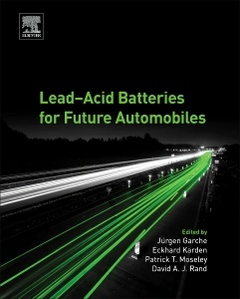Description
Lead-Acid Batteries for Future Automobiles
Coordinators: Garche Jürgen, Karden Eckhard, Moseley Patrick T., Rand David A. J.
Language: English
Subjects for Lead-Acid Batteries for Future Automobiles:
Support: Print on demand
Description
/li>Contents
/li>Readership
/li>Biography
/li>Comment
/li>
Lead-Acid Batteries for Future Automobiles provides an overview on the innovations that were recently introduced in automotive lead-acid batteries and other aspects of current research. Innovative concepts are presented, some of which aim to make lead-acid technology a candidate for higher levels of powertrain hybridization, namely 48-volt mild or high-volt full hybrids.
Lead-acid batteries continue to dominate the market as storage devices for automotive starting and power supply systems, but are facing competition from alternative storage technologies and being challenged by new application requirements, particularly related to new electric vehicle functions and powertrain electrification.
About the Editors Patrick T. Moseley, Eckhard Karden, David A. J. Rand and Jürgen Garche Introduction Jürgen Garche Abbreviations, Acronyms, Initialisms Patrick T. Moseley, Eckhard Karden, David A. J. Rand and Jürgen Garche
I Overview 1. Development trends for future automobiles and their demand on the battery Eckhard Karden 2. Overview of batteries for future automobiles Peter Kurzweil and Jürgen Garche 3. Lead–acid battery fundamentals David A. J. Rand and Patrick T. Moseley 4. Current research topics for lead-acid batteries Matthias Kuipers, Dirk Uwe Sauer, Monika Kwiecin and Philipp Schröer
II Battery Technology 5. Flooded SLI and Enhanced Flooded Batteries (EFB): State of the art Manfred Gelbke and Christian Mondoloni 6. Automotive absorbent glass mat (AGM) lead–acid batteries: state-of-the-art Automotive absorbent glass mat (AGM) lead–acid batteries: State of the art Joern Albers and Eberhard Meissner 7. Performance-enhancing materials for lead–acid battery negative plates Patrick T. Moseley, David A. J. Rand and Ken Peters 8. Positive Active Materials for lead-acid battery plates Rainer Wagner 9. Lead current collectors for lead-acid batteries R David Prengaman 10. Alternative current collectors Angel Kirchev 11. Cell design for high-rate operation Norbert Maleschitz 12. Towards sustainable road transport with the UltraBattery Lan Lam, Jun Furukawa, K. Smith and David A. J. Rand
III Application Technology 13. Lead-acid battery operation in micro-hybrid and electrified vehicles Christopher Chumchal and Dennis Kurzweil 14. Monitoring techniques for 12 V lead-acid batteries in automobiles Eberhard Schoch, Joachim Kizler, Clemens Schmucker, Britta Kronenberg, Marcus Bremmer, Jürgen Schöttle, Michel Ruch and Martin Königsmann 15. Dual battery systems for 12-Volt automotive power supply Armin Warm and Matthew Denlinger 16. Basics on lead–acid battery modeling and simulation Moritz Huck, Dirk Uwe Sauer, Julia Badeda, Jan Kabzinski and Jonathan Wirth 17. Lead-acid batteries for heavy trucks Jean Paul Douady, Liao Wang, Jean-François Sarrau, Samia Fouache and Marleen Boucoiran 18. Lead–acid batteries for E-bicycles and E-scooters Jürgen Garche
IV Product Life Cycle 19. Standards and Tests for lead-acid batteries in automotive applications Torsten Hildebrandt, Osada Akira, Shawn Peng and Timothy Moyer 20. Recycling concepts for lead-acid batteries R David Prengaman and Abbas H. Mirza
V Outlook 21. Lead–acid batteries for future automobiles: status and prospects Patrick T. Moseley, Jürgen Garche and David A. J. Rand
The main audience is the R&D community ie, chemists, chemical engineers who must develop a LAB with high power, lifetime and low cost. The book mainly has a scientific character but it also gives practical guidelines for applications of LABs in hybrid cars, downsizing concepts and standards/tests.
Eckhard received his diploma in Physics 1995 and his Ph.D. in Electrical Engineering 2001 from RWTH Aachen University of Technology with projects on CAE modeling and electrochemical impedance spectroscopy of lead-acid batteries. Having spent two and a half year as senior engineer at ISEA Institute for Power Electronics and Electrical Drives of the same university, he joined Ford Motor Company in the newly established Research and Innovation Centre (RIC) Aachen. He has been focusing on batteries for low-voltage power supply, micro, and mild hybrid applications. As a Technical Specialist, he is working closely with Ford’s global engineering centres and has been involved in the conceptual work, specifications, and component verification plans for the enhanced flooded batteries, battery sensors, and charging strategies that went into Ford’s first generations of micro-hybrid vehicles. He is an active member of German, European, and international standardization working groups for stop/start and micro-hybrid batteries.
Pat was awarded a Ph. D. for crystal structure analysis in 1968 by the University of Durham, U.K., and a D. Sc. for research publications in materials science, by the same universi
- Presents an overview of development trends for future automobiles and the demands that they place on the battery
- Describes how to adapt LABs for use in micro and mild hybrid EVs via collector construction and materials, via carbon additives, via new cell construction (bipolar), and via LAB hybrids with Li-ion and supercap systems
- System integration of LABs into vehicle power-supply and hybridization concepts
- Short description of competitive battery technologies




